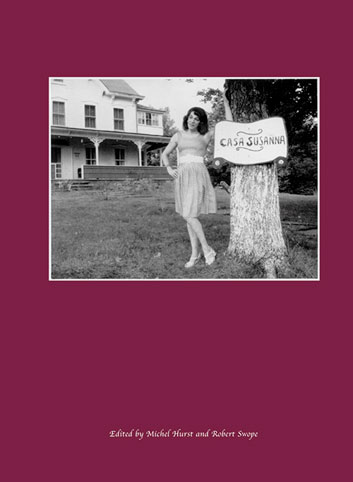
'Casa
Susanna' Documents Secret 1950's Cross-Dressing
Community
Edited by Michel Hurst & Robert Swope,
published by powerHouse Books.156 pages, 120 four-color and
black-and-white photographs,
ISBN:
978-1-57687-241-3, $29.95
Casa Susana is a compelling book that
documents the
weekend gathering place of a group of cross-dressers sometime between
the mid-1950s
and mid-1960s.
Discovered at a
New York Flea Market by Michel Hurst and Robert Swope, the photos in
the book
depict this group of individuals at a Victorian-style house in New
Jersey
called Casa Susanna. The men appear to have used the house as a safe
gathering
place to form community and spend their weekends together.
"Through
these wonderfully intimate shots -- perhaps never intended to see the
light of
day outside the sanctum of the 'house' -- Susanna and her gorgeous
friends
styled era-specific fashion shows and dress-up Christmas and tea
parties,"
the book's description notes. "As gloriously primped as these
documentary
snaps are, it is in the more private and intimate life at Casa Susanna,
where
the girls sweep the front porch, cook, knit, play Scrabble, relax at
the nearby
lake and, of course, dress for the occasion, that the stunning insight
to a
very private club becomes nothing less than brilliant and awe inspiring
in its
pre-glam, pre-drag-pose ordinariness and nascent preening and posturing
in new
identities."
Some time
ago, while at a New
York flea market, inveterate
collectors Michel Hurst and Robert Swope discovered a large body of
snapshots:
album after aged album of well-preserved images, taken roughly between
the
mid-50s and mid-60s, depicting a group of cross-dressers united around
a place
called Casa Susanna, a rather large and charmingly banal
Victorian-style house
in small-town New Jersey. The inhabitants, visitors, guests, and hosts
used it
as a weekend headquarters for a regular “girl’s life.” Someone—probably
“Susanna” or the matriarch—nailed a wonder board on a tree proclaiming
it “Casa
Susanna,” and thus a Queendom was born.
Through
these wonderfully
intimate shots - perhaps never
intended to see the light of day outside the sanctum of the
“house”—Susanna and
her gorgeous friends styled era-specific fashion shows and dress-up
Christmas
and tea parties. As gloriously primped as these documentary snaps are,
it is in
the more private and intimate life at Casa Susanna, where the girls
sweep the
front porch, cook, knit, play Scrabble, relax at the nearby lake and,
of
course, dress for the occasion, that the stunning insight to a very
private
club becomes nothing less than brilliant and awe inspiring in its
pre-glam,
pre-drag-pose ordinariness and nascent preening and posturing in new
identities.
It is not glamour for the stage but for each other, like other women
who dress
up to spend time with friends, flaunting their own sense of style.
There is an
evident pleasure of being here, at Casa Susanna, that is a liberation,
a
simplification of the conflicts inherent in a double life.
Michel
Hurst was born in France
and studied architecture in
Paris. After concluding his studies, Hurst traveled the world
extensively,
researching and documenting various vernacular decorative arts. In
1985, he
co-founded the influential twentieth century design gallery Full House
in New
York City with his partner Robert Swope, an artist—formerly of the
musical
group Beirut Slump, headed by Lydia Lunch—and filmmaker (Too Lazy to
Live).
They live and work in Easton, Pennsylvania, and New York City.
Website
| Als je
een aanvulling of opmerking hebt over deze site dan kun je een
mailtje sturen naar Transarchief |
